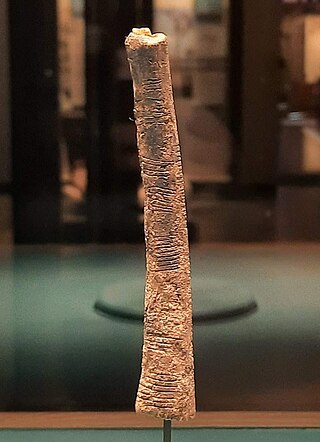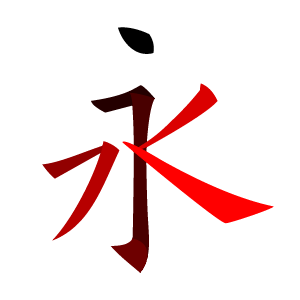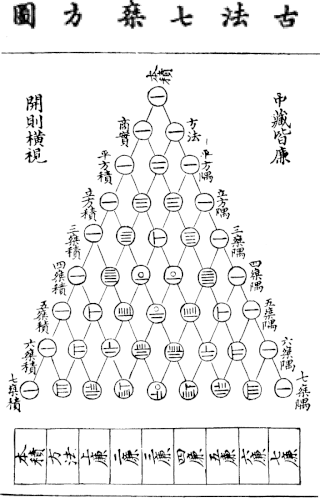
A numeral system is a writing system for expressing numbers; that is, a mathematical notation for representing numbers of a given set, using digits or other symbols in a consistent manner.
The unary numeral system is the simplest numeral system to represent natural numbers: to represent a number N, a symbol representing 1 is repeated N times.
GB/T 2312-1980 is a key official character set of the People's Republic of China, used for Simplified Chinese characters. GB2312 is the registered internet name for EUC-CN, which is its usual encoded form. GB refers to the Guobiao standards (国家标准), whereas the T suffix denotes a non-mandatory standard.

The Chinese Character Code for Information Interchange or CCCII is a character set developed by the Chinese Character Analysis Group in Taiwan. It was first published in 1980, and significantly expanded in 1982 and 1987.
The CNS 11643 character set, also officially known as the Chinese Standard Interchange Code or CSIC, is officially the standard character set of Taiwan. In practice, variants of the related Big5 character set are de facto standard.

Mojikyō, also known by its full name Konjaku Mojikyō, is a character encoding scheme. The Mojikyō Institute, which published the character set, also published computer software and TrueType fonts to accompany it. The Mojikyō Institute, chaired by Tadahisa Ishikawa (石川忠久), originally had its character set and related software and data redistributed on CD-ROMs sold in Kinokuniya stores.
The Chinese character description languages are several proposed languages to most accurately and completely describe Chinese characters and information such as their list of components, list of strokes, their order, and the location of each of them on a background empty square. They are designed to overcome the inherent lack of information within a bitmap description. This enriched information can be used to identify variants of characters that are unified into one code point by Unicode and ISO/IEC 10646, as well as to provide an alternative form of representation for rare characters that do not yet have a standardized encoding in Unicode or ISO/IEC 10646. Many aim to work for Kaishu style and Song style, as well as to provide the character's internal structure which can be used for easier look-up of a character by indexing the character's internal make-up and cross-referencing among similar characters.

Biangbiang noodles, alternatively known as youpo chemian (油泼扯面) in Chinese, are a type of Chinese noodle originating from Shaanxi cuisine. The noodles, touted as one of the "eight curiosities" of Shaanxi (陕西八大怪), are described as being like a belt, owing to their thickness and length.

The Ishango bone, discovered at the "Fisherman Settlement" of Ishango in the Democratic Republic of Congo, is a bone tool and possible mathematical device that dates to the Upper Paleolithic era. The curved bone is dark brown in color, about 10 centimeters in length, and features a sharp piece of quartz affixed to one end, perhaps for engraving. Because the bone has been narrowed, scraped, polished, and engraved to a certain extent, it is no longer possible to determine what animal the bone belonged to, although it is assumed to belong to a mammal.
In computing, a Unicode symbol is a Unicode character which is not part of a script used to write a natural language, but is nonetheless available for use as part of a text.
The Chinese, Japanese and Korean (CJK) scripts share a common background, collectively known as CJK characters. During the process called Han unification, the common (shared) characters were identified and named CJK Unified Ideographs. As of Unicode 15.1, Unicode defines a total of 97,680 characters.
Number systems have progressed from the use of fingers and tally marks, perhaps more than 40,000 years ago, to the use of sets of glyphs able to represent any conceivable number efficiently. The earliest known unambiguous notations for numbers emerged in Mesopotamia about 5000 or 6000 years ago.
A numeral is a character that denotes a number. The decimal number digits 0–9 are used widely in various writing systems throughout the world, however the graphemes representing the decimal digits differ widely. Therefore Unicode includes 22 different sets of graphemes for the decimal digits, and also various decimal points, thousands separators, negative signs, etc. Unicode also includes several non-decimal numerals such as Aegean numerals, Roman numerals, counting rod numerals, Mayan numerals, Cuneiform numerals and ancient Greek numerals. There is also a large number of typographical variations of the Western Arabic numerals provided for specialized mathematical use and for compatibility with earlier character sets, such as ² or ②, and composite characters such as ½.

CJK strokes are the calligraphic strokes needed to write the Chinese characters in regular script used in East Asian calligraphy. CJK strokes are the classified set of line patterns that may be arranged and combined to form Chinese characters in use in China, Japan, and Korea.

Code2000 is a serif and pan-Unicode digital font, which includes characters and symbols from a very large range of writing systems. As of the current final version 1.171 released in 2008, Code2000 is designed and implemented by James Kass to include as much of the Unicode 5.2 standard as practical, and to support OpenType digital typography features. Code2000 supports the Basic Multilingual Plane. Code2001 was a designed to support the Supplementary Multilingual Plane, with ISO 8859-1 characters shared with Code2000 for compatibility. A third font, Code2002, was left substantially unfinished and never officially released.
In the Unicode standard, a plane is a continuous group of 65,536 (216) code points. There are 17 planes, identified by the numbers 0 to 16, which corresponds with the possible values 00–1016 of the first two positions in six position hexadecimal format (U+hhhhhh). Plane 0 is the Basic Multilingual Plane (BMP), which contains most commonly used characters. The higher planes 1 through 16 are called "supplementary planes". The last code point in Unicode is the last code point in plane 16, U+10FFFF. As of Unicode version 15.1, five of the planes have assigned code points (characters), and seven are named.

Counting rods are small bars, typically 3–14 cm long, that were used by mathematicians for calculation in ancient East Asia. They are placed either horizontally or vertically to represent any integer or rational number.

A tally stick was an ancient memory aid device used to record and document numbers, quantities and messages. Tally sticks first appear as animal bones carved with notches during the Upper Palaeolithic; a notable example is the Ishango Bone. Historical reference is made by Pliny the Elder about the best wood to use for tallies, and by Marco Polo (1254–1324) who mentions the use of the tally in China. Tallies have been used for numerous purposes such as messaging and scheduling, and especially in financial and legal transactions, to the point of being currency.
Counting Rod Numerals is a Unicode block containing traditional Chinese counting rod symbols, which mathematicians used for calculation in ancient China, Japan, Korea, and Vietnam. The orientation of the Unicode characters follows Song dynasty convention, with digits represented as horizontal lines, and tens represented as vertical lines, which differs from Han dynasty practice which represented digits as vertical lines, and tens as horizontal lines.












